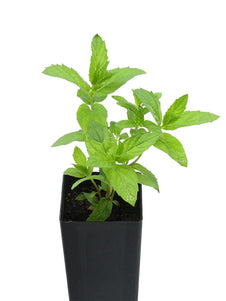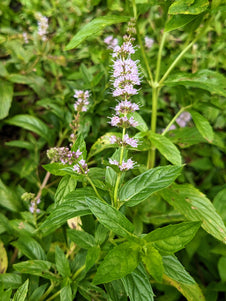



Mint - Spearmint
Mint - Spearmint
- In stock, ready to ship
- Inventory on the way

Usually available: All year
Life cycle: Perennial
Height: 40 - 90cm
Position: Sun / part shade
Soil preference: Moist / well drained
This is how we pack and send your Herb Plants to all states except TAS & WA
You will receive
- 1 Spearmint Herb Plant in a 50 X 75mm tube - General growing instructions
All of our Herb Plants are grown organically with certified organic potting mixes and fertilizers
Botanical Name: Mentha spicata
Spearmint is a medium growing evergreen, with an upright, spreading habit from 40-90cm high. The bright green foliage is highly aromatic and is supported on the typical square stems belonging to the mint family. The serrated leaves are spear shaped with a pointed end, providing the origins of the name spear – mint. The large leaves are also bumpy and quite textured with visible veins and a prominent midrib. Leaf size may reach 5-9cm long and 1.5-3cm wide. The small flowers are either pink or white, although some describe them as mauve, and appear on extended whorls. The sharply intense aroma is highest just before flowering and diminished once the flowers disappear.
Spearmint is native to Europe and western Asia, but it has been in cultivation for so long the original native range is unknown. It is naturalized in many areas of the world and was first found in North America in the 1840’s. It may become invasive if given the right conditions. Many gardeners may know this plant as Mentha viridis, but Spearmint is now called Mentha spicata. As a natural species, this mint has been responsible for several hybrid varieties including Mentha X piperita (Peppermint) and Mentha X gracilis (Gingermint). There are many mint varieties that are simply labelled ‘Spearmint’ but these are often not true Spearmint, so check the botanical name for certainty.
Spearmint is an old favourite and one of the most popular mints. It is responsible for the production of Oil of Spearmint and is used in many household products. After experiencing the fresh aroma and flavour of Spearmint inside the home, it is enlightening to have this plant in your garden in its refreshing and natural state.
Mint General
There are many Mint varieties known to herb gardeners and lovers of good cuisine, all varying slightly in flavour, aroma and appearance. They are categorized in the genus ‘Mentha’, which has up to 18 species, within the Lamiaceae family of plants. The Lamiaceae family is known as the mint family. However, the largest group of plants in the mint family is actually the delightful Salvias with their brilliantly coloured blooms. Many other commonly known herbs are also found in this family, including basil, sage, thyme and even lavender. One characteristic of this plant family is that they all yield essential oils, giving each plant its unique characteristics and even potential for medicinal use. Even the Scutellaria genus, with the unusually named Baikal Skullcap is found within this family.
The mints consist of mostly spreading and low growing perennial plants. The height range is from 10 cm to 1 meter, so not all are at ground level. Mint plants send out runners, or stolons, to help them spread by developing roots and shoots at the nodes. This allows plants to cover up to 1 meter in stem growth, in good conditions. They are all fast growing plants and due to the spreading nature, one plant is often sufficient for most gardeners. Some mints can be invasive and it is recommended that containers or in ground barriers be used. Mints can suffer from some pests like snails and aphids and may be affected by mint rust. Rust Free Mint may also be a useful addition to the garden in addition to the many other varieties.
Most mint plants have square stems, with leaves held in opposite pairs. They are often downy with a serrated margin, with a variable leaf shape and colours ranging from green to purple. The flowers are usually white to purple and present in false whorls or verticillaster or false whorl. The corolla is usually two lipped and has 4 lobes, with the upper lobe usually the largest.
Mint plants come from across the globe and will grow in most climates, including a wide range of regions across Australia. Some are annual varieties, but in cool climate zones perennial mints may best be treated as annuals and replaced each year. Generally they have high water requirements and prefer rich soils. Mint is grown commercially in Tasmania due to the ideal conditions of long summer days in high altitudes, where temperatures average 25C during the day to 15C at night. Ideal conditions usually require full sun, but part shade may be necessary as temperatures increase in warm summer regions.
Most mints have a history of traditional medicinal or herbal use for fevers, headaches and minor ailments. These plants are often used as a digestive aid in the form of a herbal spearmint tea. The essential oil is also antiseptic and may be toxic in very high doses. They should be avoided by pregnant women and must not be given, or placed next to the face of babies and young children, due to the potential for breathing difficulties associated with menthol.
Mint hybridizes very easily, so there are many varieties available to suit any garden. In fact, if you have mixed plants some may hybridize in your own garden. The most popular choices are Spearmint, Peppermint and Applemint. However, many varieties in our collection, such as Ginger Mint, Eau de Cologne, Chocolate Mint and many others are also becoming well known.
Growing Conditions
Spearmint prefers a shaded position, although it will also do very well in full sun or semi-shade. All soil types are acceptable, but rich organic and loamy soil is ideal. All mints have a love of water, so moist or even damp soil is well received by Spearmint. Dry soils are not tolerated well, so water should be provided in dry seasons especially if the plant is in full sun. Spearmint should do well in most temperate climate regions.Propagation may be via division of existing clumps. Container planting is advised if there is concern about the spreading nature of mint plants. The aroma is highest before flowering, so branches and leaves should be harvested for drying just prior to the blooms opening.
Culinary Uses
Spearmint has a cooling effect on the palate, although it is not as strong as Peppermint. Like most mints, it may be used for whatever culinary purpose you desire. Spearmint works well with peas, vegetable and fruit salads, or meat, poultry and fish dishes. It does equally well with desserts, herbal tea and cold drinks. In particular, Spearmint is known for its role in preparing the alcoholic drinks mojito and mint julep. It is very easy to pick a few leaves and simply add to any type of lemonade or cool drink for an exotic effect. The leaves should be used fresh or added to dishes at the last minute as the flavour diminishes quickly after harvesting and upon cooking.
Medicinal Uses
Spearmint has a long history of medicinal use, although it contains less menthol than Peppermint and some other varieties. The main active constituent in Spearmint is carvone, which provides the distinctive aroma. Traditionally, Spearmint was considered antifungal, antibacterial, antiviral, antiseptic, mildly analgesic, antispasmodic, carminative, effective for stomach complaints, used for regulating menstrual cycles, to treat headaches and insomnia, as an insecticide, and as a restorative and stimulant.
Today, Spearmint may be used as an herbal tea and is useful for repelling insects and easing the itch or pain from insect bites. It may also be used to treat minor skin irritations or wounds due to its antiseptic properties. Minor relief may be obtained for swelling due to bruises or arthritis. Most commonly, Spearmint is used like many other mints as a digestive aid, as a calming relaxant or to assist with insomnia and headaches.
Other Uses
Spearmint is cultivated commercially for the ‘oil of spearmint’ essential oil. Spearmint is used to flavour toothpaste, mouthwash, toiletries, confectionary and add an aroma to some shampoos or soaps.
All information provided on this website is for informational purposes only. Please seek professional advice before commencing any treatment.





